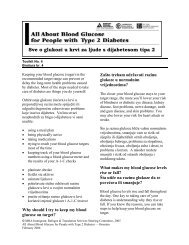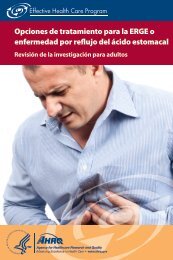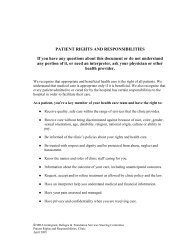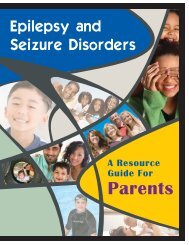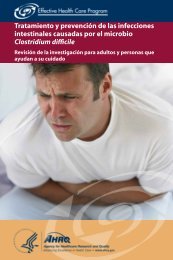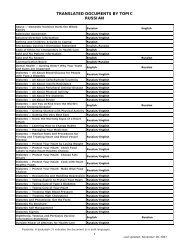cuidado del bebé care for baby - Health Translations
cuidado del bebé care for baby - Health Translations
cuidado del bebé care for baby - Health Translations
You also want an ePaper? Increase the reach of your titles
YUMPU automatically turns print PDFs into web optimized ePapers that Google loves.
Some additional suggestions <strong>for</strong> calming your <strong>baby</strong> include:<br />
• Envuelva a su infante en una cobjita. A muchos bebés les gusta la seguridad que les<br />
da.<br />
• Wrap your infant snugly in a receiving blanket. Many babies love the security this<br />
provides.<br />
• Ofrézcale a su bebé un chupón. Si le está dando pecho, deje que succione en su<br />
pecho. Los bebés se sienten mejor cuando están succionando.<br />
• Offer your <strong>baby</strong> a pacifier. If you are breast feeding, let him suckle at the breast.<br />
Babies are com<strong>for</strong>ted through sucking.<br />
• Ponga música o cántele a su bebé.<br />
• Play music or sing to your <strong>baby</strong>.<br />
• Intente con un columpio, mecedora, cangurera o cabestrillo, o camine con la carreola.<br />
A los bebés les gusta el movimiento.<br />
• Try a swing, rocker, front pack or sling or a walk in the stroller. Babies love motion.<br />
Si su bebé continúa llorando, esto puede significar que está enfermo o algo le duele. Si el<br />
llanto suena como que algo le duele o continúa por largos períodos, recuerde permanecer<br />
calmado y llame a su médico.<br />
If your <strong>baby</strong> continues to cry this may mean he is sick or in pain. If the cries sound<br />
painful or continue <strong>for</strong> long periods, remember to remain calm and call your health <strong>care</strong><br />
provider.<br />
PONER/QUITAR EL PAÑAL Y ELIMINACIÓN — DIAPERING/ELIMINATION<br />
Necesita revisar el pañal de su bebé frecuentemente. Es normal usar ocho (8) a doce (12)<br />
pañales al día. La mayoría de los recién nacidos "mojan" el pañal cinco a seis (5-6) veces<br />
cada día en la primera semana y aumenta a seis a diez (6-10) veces de ahí en a<strong>del</strong>ante.<br />
Your <strong>baby</strong>’s diaper needs to be checked frequently. It is not uncommon to use eight (8) to<br />
twelve (12) diapers a day. Most newborns “wet” five to six (5-6) times each day the first<br />
week and increase to six to ten (6-10) times thereafter.<br />
Las primeras heces fecales, llamadas meconio, son negras, pegajosas y sin olor. En los<br />
siguientes días, el excremento va a cambiar de verdoso-negro, a café, a café amarillento.<br />
Los bebés que están tomando pecho generalmente defecan de color amarillo. Algunos<br />
bebés defecan una vez al día, otros cuatro a seis (4-6) veces por día y algunos infantes<br />
defecan cada dos a tres (2-3) días. Todos los patrones son normales. Si el excremento es<br />
muy acuoso o contiene moco o sangre, avise al personal médico que atiende a su bebé.<br />
© MHA Immigrant, Refugee & Translation Services Steering Committee, 2004<br />
Care <strong>for</strong> Mother— Spanish<br />
October 2004<br />
11



